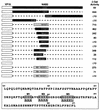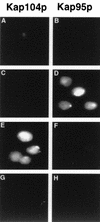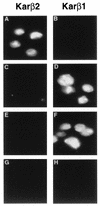Identification and functional characterization of a novel nuclear localization signal present in the yeast Nab2 poly(A)+ RNA binding protein
- PMID: 9488461
- PMCID: PMC108859
- DOI: 10.1128/MCB.18.3.1449
Identification and functional characterization of a novel nuclear localization signal present in the yeast Nab2 poly(A)+ RNA binding protein
Abstract
The nuclear import of proteins bearing a basic nuclear localization signal (NLS) is dependent on karyopherin alpha/importin alpha, which acts as the NLS receptor, and karyopherin beta1/importin beta, which binds karyopherin alpha and mediates the nuclear import of the resultant ternary complex. Recently, a second nuclear import pathway that allows the rapid reentry into the nucleus of proteins that participate in the nuclear export of mature mRNAs has been identified. In mammalian cells, a single NLS specific for this alternate pathway, the M9 NLS of heterogeneous nuclear ribonucleoprotein A1 (hnRNPA1), has been described. The M9 NLS binds a transport factor related to karyopherin beta1, termed karyopherin beta2 or transportin, and does not require a karyopherin alpha-like adapter protein. A yeast homolog of karyopherin beta2, termed Kap104p, has also been described and proposed to play a role in the nuclear import of a yeast hnRNP-like protein termed Nab2p. Here, we define a Nab2p sequence that binds to Kap104p and that functions as an NLS in both human and yeast cells despite lacking any evident similarity to basic or M9 NLSs. Using an in vitro nuclear import assay, we demonstrate that Kap104p can direct the import into isolated human cell nuclei of a substrate containing a wild-type, but not a defective mutant, Nab2p NLS. In contrast, other NLSs, including the M9 NLS, could not function as substrates for Kap104p. Surprisingly, this in vitro assay also revealed that human karyopherin beta1, but not the Kap104p homolog karyopherin beta2, could direct the efficient nuclear import of a Nab2p NLS substrate in vitro in the absence of karyopherin alpha. These data therefore identify a novel NLS sequence, active in both yeast and mammalian cells, that is functionally distinct from both basic and M9 NLS sequences.
Figures









Similar articles
-
Kap104p-mediated nuclear import. Nuclear localization signals in mRNA-binding proteins and the role of Ran and Rna.J Biol Chem. 1999 Oct 8;274(41):29031-7. doi: 10.1074/jbc.274.41.29031. J Biol Chem. 1999. PMID: 10506153
-
Functional conservation of the transportin nuclear import pathway in divergent organisms.Mol Cell Biol. 1998 Jul;18(7):4141-8. doi: 10.1128/MCB.18.7.4141. Mol Cell Biol. 1998. PMID: 9632798 Free PMC article.
-
Kap104p: a karyopherin involved in the nuclear transport of messenger RNA binding proteins.Science. 1996 Oct 25;274(5287):624-7. doi: 10.1126/science.274.5287.624. Science. 1996. PMID: 8849456
-
Molecular mechanisms of nuclear protein transport.Crit Rev Eukaryot Gene Expr. 1997;7(1-2):61-72. doi: 10.1615/critreveukargeneexpr.v7.i1-2.40. Crit Rev Eukaryot Gene Expr. 1997. PMID: 9034715 Review.
-
Nuclear localization signals for four distinct karyopherin-β nuclear import systems.Biochem J. 2015 Jun 15;468(3):353-62. doi: 10.1042/BJ20150368. Biochem J. 2015. PMID: 26173234 Review.
Cited by
-
Regulated nucleo/cytoplasmic exchange of HOG1 MAPK requires the importin beta homologs NMD5 and XPO1.EMBO J. 1998 Oct 1;17(19):5606-14. doi: 10.1093/emboj/17.19.5606. EMBO J. 1998. PMID: 9755161 Free PMC article.
-
A PY-NLS nuclear targeting signal is required for nuclear localization and function of the Saccharomyces cerevisiae mRNA-binding protein Hrp1.J Biol Chem. 2008 May 9;283(19):12926-34. doi: 10.1074/jbc.M800898200. Epub 2008 Mar 14. J Biol Chem. 2008. PMID: 18343812 Free PMC article.
-
Nuclear import of zinc binuclear cluster proteins proceeds through multiple, overlapping transport pathways.Eukaryot Cell. 2003 Apr;2(2):209-21. doi: 10.1128/EC.2.2.209-221.2003. Eukaryot Cell. 2003. PMID: 12684370 Free PMC article.
-
Exchange of the basic domain of human immunodeficiency virus type 1 Rev for a polyarginine stretch expands the RNA binding specificity, and a minimal arginine cluster is required for optimal RRE RNA binding affinity, nuclear accumulation, and trans-activation.J Virol. 2001 Mar;75(6):2957-71. doi: 10.1128/JVI.75.6.2957-2971.2001. J Virol. 2001. PMID: 11222721 Free PMC article.
-
The multitasking polyA tail: nuclear RNA maturation, degradation and export.Philos Trans R Soc Lond B Biol Sci. 2018 Nov 5;373(1762):20180169. doi: 10.1098/rstb.2018.0169. Philos Trans R Soc Lond B Biol Sci. 2018. PMID: 30397105 Free PMC article. Review.
References
-
- Adam S A, Gerace L. Cytosolic proteins that specifically bind nuclear location signals are receptors for nuclear import. Cell. 1991;66:837–847. - PubMed
-
- Aitchison J D, Blobel G, Rout M P. Kap104p: a karyopherin involved in the nuclear transport of messenger RNA binding proteins. Science. 1996;274:624–627. - PubMed
Publication types
MeSH terms
Substances
LinkOut - more resources
Full Text Sources
Other Literature Sources
Molecular Biology Databases
Miscellaneous
